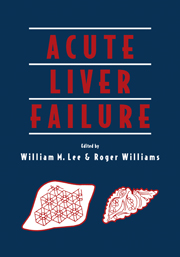Book contents
- Frontmatter
- Contents
- Preface
- Foreword
- Acknowledgments
- Contributors
- Part One Clinical Syndrome and Etiology
- Part Two Mechanisms of Disease and Multisystem Involvement
- Part Three Intensive Care Management
- Part Four Transplantation
- Part Five Artificial and Bioartificial Liver Devices
- 18 Extracorporeal liver support: historical background and critical analysis
- 19 Hepatocyte culture and bioreactor design for liver support systems
- 20 Clinical experience with an extracorporeal liver assist device
- Part Six Other Applications
- Index
- Plate section
19 - Hepatocyte culture and bioreactor design for liver support systems
from Part Five - Artificial and Bioartificial Liver Devices
Published online by Cambridge University Press: 20 May 2010
- Frontmatter
- Contents
- Preface
- Foreword
- Acknowledgments
- Contributors
- Part One Clinical Syndrome and Etiology
- Part Two Mechanisms of Disease and Multisystem Involvement
- Part Three Intensive Care Management
- Part Four Transplantation
- Part Five Artificial and Bioartificial Liver Devices
- 18 Extracorporeal liver support: historical background and critical analysis
- 19 Hepatocyte culture and bioreactor design for liver support systems
- 20 Clinical experience with an extracorporeal liver assist device
- Part Six Other Applications
- Index
- Plate section
Summary
INTRODUCTION
Massive necrosis of hepatocytes in acute liver failure destroys synthesis, metabolism, and elimination pathways of the liver. For the past 20 years, artificial liver systems have been under development with the aim of providing temporary extracorporeal liver support (Wolf and Munkelt 1975). Most recently, development of “bioartificial” liver support systems has utilized liver cells cultivated in bioreactors to provide the biological activity of liver cells in extracorporeal systems (Pappas 1988). In this review, liver cell culture systems, bioreactor design and construction, animal experiments with hybrid liver support systems, and initial clinical applications are described.
In vitro studies have demonstrated the long-term external metabolic function of primary isolated hepatocytes within bioreactors. These cell systems are capable of supporting essential liver functions. Animal experiments have verified the possibility of scaling-up the bioreactors for use in man. However, since there is no reliable animal model in which the treatment of acute liver failure can be properly assessed, results obtained from experimental studies to date, however promising, have limited relevance. The small number of clinical studies performed so far is not sufficient to allow conclusions to be drawn on improvements in the therapy of acute liver failure. Although important progress has been made in the development of these systems, the multiple different hepatocyte culture models and bioreactor constructions which are being described in the literature are an indication of the competition (and perhaps the limited successes) in this field of medical research.
- Type
- Chapter
- Information
- Acute Liver Failure , pp. 245 - 254Publisher: Cambridge University PressPrint publication year: 1996
- 2
- Cited by

